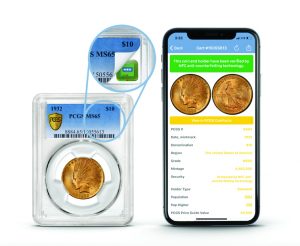
Coin collecting online is popular and can be rewarding. One of the most important ways collectors are immersing themselves in the hobby is diving headfirst into the vast world of coin-related information. It has often been said that one should “buy the book before the coin.” This is still true, though in the 21st century, the world of coins has increasingly migrated the bulk of its collective knowledge onto the Information Superhighway.
Internet Equalizes the Coin Playing Field
“It’s really astonishing what’s available online – auction records, price guides, grading, and authentication details,” remarks Ian Russell, owner and president of online coin auction firm GreatCollections. “If you’re a collector wanting to buy, for example, a 1913-S Barber quarter, there are hundreds of images available of that coin for someone to look at and better understand everything about the coin. This is one of the great things about digital technology – it levels the playing field for everybody in the hobby.”
In the past, dealers were the only people who may have had access to the type of information now readily available to collectors with a simple Google search. “If they didn’t have that information readily available online, dealers had their inventories and dealer networks for sharing data on coins. Now, everything from images of coins to pedigrees and so much more is available to anyone.”
The owner of the Irvine, California, rare coin auction house says, “It all comes down to sharing information.” He says the information can be engrossing, to the point that some people he knows easily spend 10 or more hours a day surfing the ‘net for coins. “Of course, not everyone is going to feel compelled to spend all that time on the internet or using apps. Many people feel daunted even going on the internet, let alone feel comfortable navigating all the technology out there.”
Getting Started Online
How do internet newbies begin educating themselves about precious metals and collectible coins online? “It’s important not to feel overwhelmed by the technology or the vast amounts of information out there,” says Russell. “If you want to go online to study coins, it’s best to do it one step at a time. Some don’t realize how easy it is to use the internet, apps, or other technology available.”
Russell encourages people to become familiar with the workings of a smartphone or computer and to become comfortable using them. He says collectors and investors should acquaint themselves with apps but realize there’s a learning curve with technology and to forgive themselves if they don’t grasp the basic workings of a phone app or internet database overnight.
He says navigating the internet and other forms of digital technology may be understandably frustrating for the newcomer. “But it’s worth the journey because there is just so much information out there at your fingertips,” he relates. “Take auction archives. At GreatCollections.com, we have more than one million records with three million images – don’t forget the coin censuses, population reports, and everything else out there, too.”
Choose Trusted Resources
Russell advises collectors and investors to choose vetted resources when looking up rare coin-related information and consider the context of the marketplace when referring to sales data. “If you’re researching auction results and finding that a certain coin sold for $2,000 six months ago, bear in mind that with the pace the market is moving now that same coin might take $2,500. Of course, the market goes up and down, and this is one reason you need to stay on top of the trends in the hobby – that’ll help you make more informed decisions as you digest the information you’re researching.”
Bidding Online

Coin values often make headlines, not just inside the hobby but outside, too. The fall of the auctioneer’s gavel on some of the most important trophy coins in the world lead many to the Stack’s Bowers Galleries website and auction app just to take glimpses of the coins and to bid on other rare coin treasures.
“It was immediately obvious that bidders enjoyed the ease of use and detailed information our auction software provides,” says Stack’s Bowers Galleries Vice President Christine Karstedt. “One aspect we did not anticipate was clients who personally attended the auction session would enthusiastically use the program in the auction room to execute their bids anonymously rather than be seen raising their bidder paddles. The added flexibility of being able to bid from a cell phone or tablet was also well received.” She says the auction company is always working on new features and improvements for various platforms, including iOS and Android smartphones as well as conventional internet browsers for laptops and desktops.
“One new feature we are excited to bring to market is the complete redesign of our live bidding screen, which will capitalize on the unique, engaging auction presentation only available at Stack’s Bowers Galleries through our full broadcast production facility, Griffin Studios,” she says. “The more detail provided by the images and our exclusive content assists collectors by having the information they need for much of their decision making at their fingertips.”
High Res Viewing
Among the advancements Stack’s Bowers Galleries has made in its imaging is the development and improvement of Coins in Motion technology, which offers ultra-high resolution video animations of auction highlights and provides visual depictions of how luster moves on a coin when rotating as if being viewed in-hand.
“Today, technology plays a more important role in numismatics than ever before as more and more lot viewing, numismatic research and purchasing is being done online,” remarks Karstedt. YouTube, Facebook, and other online platforms have further enabled the Stack’s Bowers Gallery team the ability to answer client questions with videos and educate collectors on coins and other numismatic items. “The last two years of lockdowns have accelerated this already shifting numismatic landscape and we are truly now in the age of digital lot viewing.”
Grade – A Technologies for Coins
 While the bullion companies and auction houses deliver apps and software to collectors and investors spanning the globe, third-party grading companies are also helping to drive the digital revolution. When Professional Coin Grading Service (PCGS) was founded in the mid-1980s, the internet was still a novel invention. Yet, even in the relatively analog 1980s, PCGS was utilizing digital technology to help build the newly emerging marketplace for slabbed coins.
While the bullion companies and auction houses deliver apps and software to collectors and investors spanning the globe, third-party grading companies are also helping to drive the digital revolution. When Professional Coin Grading Service (PCGS) was founded in the mid-1980s, the internet was still a novel invention. Yet, even in the relatively analog 1980s, PCGS was utilizing digital technology to help build the newly emerging marketplace for slabbed coins.
“Just take a look at the American Numismatic Exchange, which was an electronic trading arm of PCGS that facilitated sight-unseen bidding in the years after our founding in 1986,” remarks PCGS President Stephanie Sabin. “Of course, that was back in the late 1980s, when third-party grading was just getting started and new investors were pouring into the market,” she adds.
By the 1990s, PCGS was jumping onto the rapidly expanding internet universe by launching PCGS.com in 1996. “This evolved into PCGS CoinFacts in 1999 and a couple years later, in 2001, we brought the PCGS Set Registry online to offer the first such collecting platform anywhere on the internet.”
The evolution of the smartphone in the first decade of the 2000s meant companies such as PCGS were adapting their technology for cell phones. “PCGS brought a series of innovative apps to the fore, including PCGS CoinFacts, bullion-pricing resource Coinflation, and PCGS Cert Verification.” The latter enables collectors and dealers to tap their phones to PCGS holders embedded with Near-Field Communication (NFC) devices to immediately reveal more information about the coin within and verify it is indeed the coin stated on the label.
This story about how to get started coin collecting online previously appeared in COINage magazine. Story by Joshua McMorrow-Hernandez. To subscribe to COINage magazine click here.












